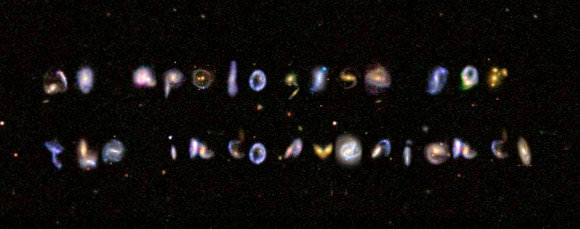[/caption] A new class of galaxy clusters has been identified by volunteers and astronomers of the Galaxy Zoo project, together with the Sloan Digital Sky Survey. These clusters are rare, and have apparently gone unnoticed before, despite their unusual linear properties. Astronomers believe the identification of these types of clusters depend on the visual inspection of large numbers of galaxies, a feat which has only recently been made possible by the Galaxy Zoo project, and this may explain why they haven't been discovered until now. "Space is, after all, really big," said the Galaxy Zoo scientists, "and full of really surprising things."
These clusters are unusually elongated, possess young and highly dynamic galaxy populations, and most unexpectedly, present neatly typeset, left-justified, messages written in the English language. One sample even includes punctuation similar to an exclamation mark. (See image below.) [caption id="attachment_28349" align="aligncenter" width="580" caption="SDSS colour composite image (vri) for another unusual galaxy cluster, at RA = ?2h61m12s, Dec = +124?17?72?? , identified by Galaxy Zoo participants."]
[/caption] The occurrence of these new galaxy phenomena could potentially lend support to some of the more exotic models for Dark Energy or modified gravity, which one of the Universe Today trolls may find extremely notable. More controversially, as most occurrences of English sentences are considered to be the work of intelligent beings, the existence of these messages might indicate intelligent life beyond our own.
Conversely, however, they could indicate that many phenomena usually attributed to intelligent life on Earth may actually occur spontaneously, without any thought necessarily being involved at all. While these new discoveries may have profound implications for cosmology, the most important thing to consider is the date of this publication, being April 1.
The Galaxy Zoo team stresses that, despite their implausible appearance, the galaxies comprising each individual character in the figures presented here are taken directly from the SDSS multicolour composite imaging. Note, however, that some degree of translation and rotation has been performed to the individual characters, for presentation purposes.
 Universe Today
Universe Today
